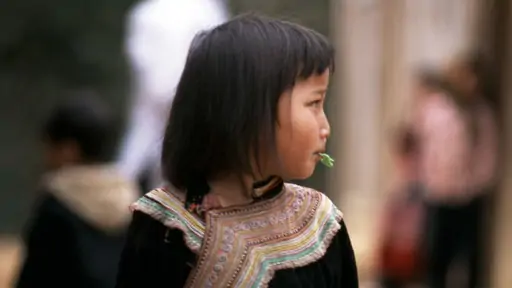Indigenous Calendar February, 2011: Childish Hmong Leaf Music

I was in northwestern Vietnam, close to the Chinese border. This mountainous area is where most of that country's indigenous peoples are concentrated. Most visitors take a two- or three-day, organized tour from Ha Noi to the Alpine-like town of Sa Pa in time for the Saturday market and to visit, among others, the Hmong indigenous people. Sa Pa and the surrounding area have, not surprisingly, become very commercialized because of this weekend influx of tourists.
A few hours away is the much smaller town of Bac Ha. Its market day is Sunday but that market goes almost unnoticed by tourists as they are whisked back to Ha Noi. Monday is a school day and I'd already made plans to spend the day visiting some surrounding, indigenous villages and to spend time in their schools.
I witnessed with some sadness that all the academic classes were conducted in Vietnamese and using the culturally Viet-centered national curriculum. This national education policy makes it harder for indigenous children to understand the material and leads to a high drop-out rate among them.
The physical education class was even more saddening. I'd heard of "re-education" of indigenous peoples in the former South Vietnam following reunification in 1975 but here I felt I was seeing it in the former North. Children of all ages were being militarily drilled as though they were army cadets instead of kindergarten, elementary and middle school children.
Then at a school in a Hmong village it was time for recess and I finally saw children playing. One girl in particular caught my attention. There was nothing remarkable about her compared to the other kids yet she appeared to be something of a loner. Through a long lens I saw that she was chewing a leaf — something I dismissed as normal for a girl of eight or nine while playing. But there was something unusual about her deep concentration. It was then that I learned that she was not chewing the leaf after all but playing a tune on it. The leaf is the oldest musical "instrument" known to the Hmong and this girl had inherited the skill of "playing" it across hundreds of generations.
I remember thinking how much the Vietnamese national education curriculum misses out by being as narrowly focused as it is and how much this girl could teach the educational policy makers if only they would listen.
The Hmong are featured in our documentary, Indigenous Peoples of Southeast Asia.
If you enjoyed reading this article, please consider supporting independent, advertising-free journalism by buying us a coffee to help us cover the cost of hosting our web site. Please click on the link or scan the QR code. Thanks!


